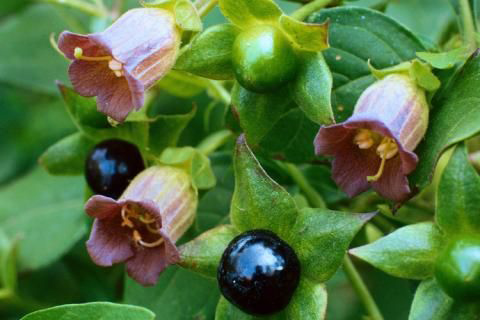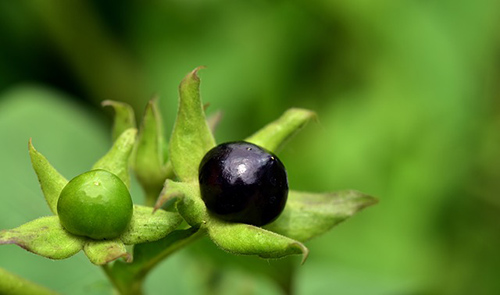Contents

In the 16th century, an outstanding Italian botanist, Mattioli, translated and commented on Dioscorides’s work. He said that the Tuscans called the belladonna plant herba bella donna.
During the Medieval Renaissance, Italian women used this plant to dilate their pupils, which was highly fashionable. However, women were not the only ones that used this herb. Sorcerers and poisoners soon found that an intake of belladonna caused hallucinations, delirium, and a range of other effects on the body. When taken in a certain amount, it could also cause death.
Linnaeus, the great Swedish naturalist of the 18th century, called the plant Atropa Belladonna from this notable and different toxic effect. Atropos was one of the three witches who, in the Greek myths, had the life thread of all humans in her hands. Atropos was supposed to cut the thread at a whim.
In the 19th century, biochemistry and physiology developments allowed scientists to isolate atropine, an essential alkalide the belladonna contains. Scientific research discovered many of atropine’s effects on the body and its therapeutic applications. It is currently irreplaceable in controlled doses in medical science, especially in anesthetics.

Belladonna Plant Scientific Facts
- Other names: Black cherry, deadly nightshade, dwale, poison black cherry.
- French: Belladone.
- Spanish: Belladona.
- Environment: The plant grows wild in mountainous and shady forests in southern and central Europe and South America.
- Description: This vigorous plant of the Solanaceae family grows up to 180 cm high and is oval-shaped. It has large, solitary, bell-shaped purple or violet flowers and bright blackberries like cherries.
Healing Properties and Warnings
The whole plant, especially its leaves, contains potent alkaloids (atropine and hyoscine). Atropine is parasympathetic, that is to say, a substance that blocks the transmission of the nervous pulse at the tips of the parasympathetic nervous system. These are its most essential properties:
- Mydriatic. It produces dilation of the pupils.
- It is antispasmodic. It relaxes the digestive tract, urinary system, and muscles, thus alleviating spasms and colic.
- Antisecretory. It decreases the secretions of all digestive glands, including salivary glands (it causes a dry mouth).
- Antiarrhythmic. It is used for bradycardia (slow heartbeat rate) and regulates the rate.
- Antiasthmatic. Relaxes the muscles of the bronchi, increasing their diameter (broncho-dilating effect).
The belladonna plant and its most important active component, atropine, have many medicinal uses. Atropine is widely used in ophthalmology because of its effects on the pupils. It is also used for spasms, colic of the urinary and digestive systems, and heart rate disorders.
WARNINGS

The mildly sweet berries of the belladonna plant look like cherries, so children can mistake them. Around ten berries can kill an adult, and only three or four berries can kill a child. Poisoning appears with nervous excitation, dilated pupils, blurred vision, dry mouth, tachycardia, and facial reddening. First aid involves inducing vomiting and administering charcoal dissolved in water, to which magnesium sulfate can be added. The victim must be immediately taken to a hospital.
Belladonna as a medicinal herb is not recommended since the correct dose is quite tricky to apply, thus producing poisoning. Font Quer, a great Spanish pharmacist and botanist, wrote in his book Medicinal Herbs: The Renewed Dioscorides that he caught a cold one day and had asthma symptoms. He prepared what seemed to be a mild infusion of belladonna leaves. A few hours later, he could not swallow; he was suffering from the side effects of a belladonna overdose.
Only professionals can correctly use the belladonna plant to kill and heal. Due to its decisive action, its active principle, atropine, is safer in medicines whose dose is perfectly known.
DISCLAIMER: All content on this website is presented solely for educational and informational objectives. Do not rely on the information provided as a replacement for advice, diagnosis, or treatment from a qualified medical expert. If you are pregnant, nursing, or have any preexisting medical concerns, talk to your doctor before using any herbal or natural medicines.
REFERENCES
- George D. Pamplona-Roger, M.D. “Encyclopedia of Medicinal Plants.” George D. Pamplona-Roger, M.D. Encyclopedia of Medicinal Plants. Ed. Francesc X. Gelabert. Vols. 1 San Fernando de Henares: Editorial Safeliz, 2000. 352, 353. Print.[belladonna plant]
- PubMed: https://pubmed.ncbi.nlm.nih.gov/
- U.S. Pharmacopeia (USP) Herbal Medicines Compendium: https://hmc.usp.org/
- European Medicines Agency (EMA): https://www.ema.europa.eu/en
- Google Scholar (for a broader search of scholarly literature): https://scholar.google.com/
